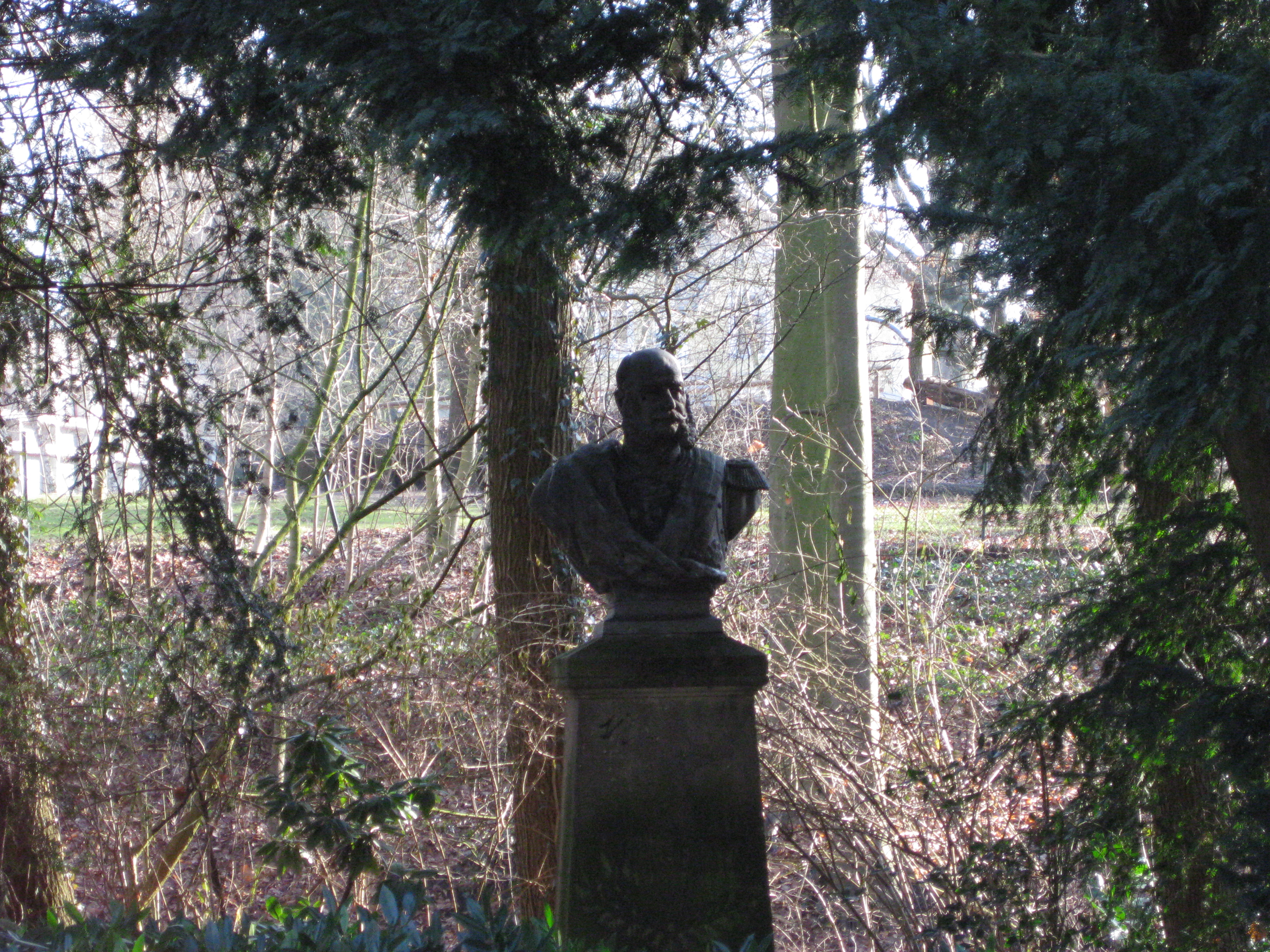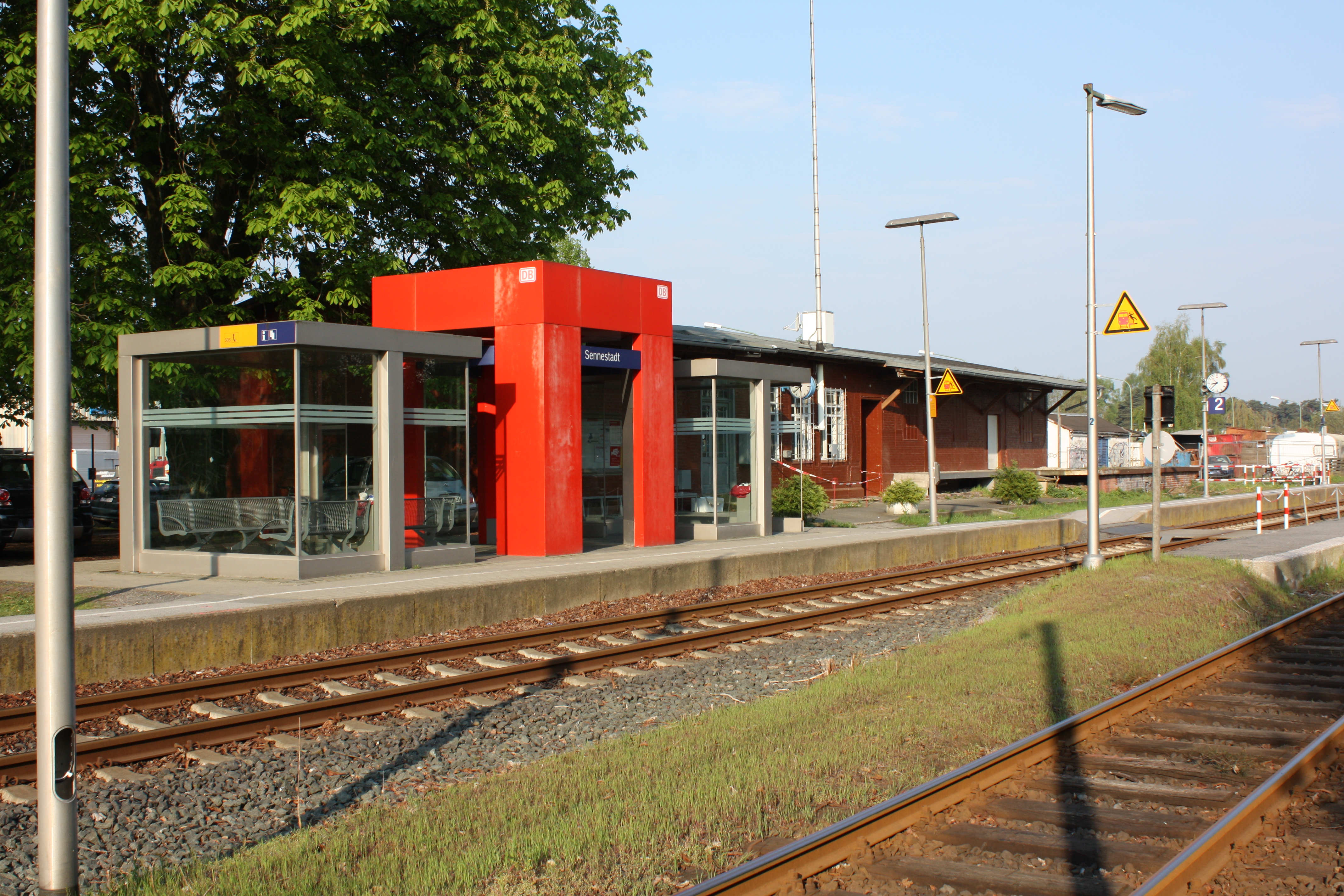|
Brackwede Station
Brackwede station is the second most important station in the city of Bielefeld in the German state of North Rhine-Westphalia, after Bielefeld Hauptbahnhof. It was opened in 1847 with the opening of the Cologne-Minden trunk line. It is classified by Deutsche Bahn as a category 4 station. Train services are operated by NordWestBahn and Eurobahn. Station environment Brackwede station has six tracks. The platform for tracks 5 and 6 was completely renovated for Expo 2000 and the reactivation of the Osnabrück–Bielefeld railway to Osnabrück; the height of the platform was raised to 76 cm and given weather protection. The remaining tracks have a platform height of 38 cm. The platforms are accessible via a pedestrian tunnel that goes from Eisenbahnstraße under the railway tracks and the ''Ostwestfalendamm'' expressway to the ''Naturbad Brackwede'' (natural bathing pool) on the border of district of Quelle. The tunnel is the main pedestrian and cycling route between ... [...More Info...] [...Related Items...] OR: [Wikipedia] [Google] [Baidu] |
Brackwede
Bielefeld () is a city in the Ostwestfalen-Lippe Region in the north-east of North Rhine-Westphalia, Germany. With a population of 341,755, it is also the most populous city in the administrative region (''Regierungsbezirk'') of Detmold and the 18th largest city in Germany. The historical centre of the city is situated north of the Teutoburg Forest line of hills, but modern Bielefeld also incorporates boroughs on the opposite side and on the hills. The city is situated on the ', a hiking trail which runs for 156 km along the length of the Teutoburg Forest. Bielefeld is home to a significant number of internationally operating companies, including Dr. Oetker, Gildemeister and Schüco. It has a university and several technical colleges (''Fachhochschulen''). Bielefeld is also famous for the Bethel Institution, and for the Bielefeld conspiracy, which satirises conspiracy theories by claiming that Bielefeld does not exist. This concept has been used in the town's marketing an ... [...More Info...] [...Related Items...] OR: [Wikipedia] [Google] [Baidu] |
Verl
Verl () is a town in the district of Gütersloh in the state of North Rhine-Westphalia, Germany. It is approximately 15 km south of Bielefeld and 10 km east of Gütersloh. In the 19th century two citizens of Verl, Johannes Otto and Ferdinand Bredeik (Bredeick), founded two towns in Ohio, USA: Delphos and Ottoville. Since the 1990s Verl has been an official sister city of both towns. History The name Verl was first mentioned in the expression 'Henricus de Verlo', which can be found in a charter from 1264. The designation probably relates to the farm estate Meier zu Verl, which belonged to a group of four estates that presumably came into existence around the turn of the first millennium. Some earlier documented references to estates in this area can be dated back to the year 1188. In 1512, a chapel was built in the farming community. This chapel was turned into a parish church in 1577 and, since then, has marked the social center for the communities of Verl, Sende a ... [...More Info...] [...Related Items...] OR: [Wikipedia] [Google] [Baidu] |
Versmold
Versmold (; wep, Vassem) is a town in Gütersloh District in the German state of North Rhine-Westphalia. It is located some 30 km west of Bielefeld. History In 1096 Versmold was first mentioned in a document, and is thus one of the oldest known settlements in the region. The name "-mold" alludes to "melle", "mal" a location of a court. Situated between the bishoprics Osnabrück and Münster, the possession of Versmold was disputed for a long time in the high Middle Ages. The population tried to protect themselves as well as they could. The St. Petri church was built as a "Wehrkirche" for defense. After 1277, when the counts of Ravensberg acquired possession of the region of Versmold, the situation changed. Versmold formed the westernmost town of the historic county of Ravensberg with its capital Bielefeld. After the War of the Jülich Succession in 1614 the county came to Brandenburg and later to Prussia. Within predominantly Catholic Westphalia, the county of Ravensbe ... [...More Info...] [...Related Items...] OR: [Wikipedia] [Google] [Baidu] |
Steinhagen, North Rhine-Westphalia
Steinhagen is a municipality in the district of Gütersloh in the state of North Rhine-Westphalia, Germany. It is located on the south slope of the Teutoburg Forest, approx. 10 km west of Bielefeld and 15 km north of Gütersloh. The village is well known for producing Schnaps made from juniper berries which are distilled three times. The Schnaps is called Steinhäger or Schinkenhäger and can be clear or dark when unfiltered. Geography Steinhagen is in the Ems River basin on the southern slopes of the Teutoburg Forest, which runs through the northwestern portion of the municipality. This mountain range is the eastern boundary of the Munsterland and of the Westphalian Bay. Steinhagen's highest point is 306 meters above sea level. The Kotte pond is 70 meters at the deepest. The city of Bielefeld is 10 km to the west and Gütersloh Gütersloh () is a city in North Rhine-Westphalia, Germany, in the area of Westphalia and the administrative region of De ... [...More Info...] [...Related Items...] OR: [Wikipedia] [Google] [Baidu] |
Bielefeld Stadtbahn
The Bielefeld Stadtbahn is a metre gauge light rail (i.e. ''Stadtbahn'') network in the German city of Bielefeld, North Rhine-Westphalia, Germany. The system does include some segments built to rapid transit standards. It is operated by moBiel, a subsidiary of the Bielefeld municipal authority (''Stadtwerke''), and integrated in the Westfalentarif transport association. It served 32.77 million passengers in 2012. History The old tram ''(Straßenbahn)'' network was rebuilt into a three-line ''Stadtbahn'' (light rail) network between 1978 and 1991, with the official inauguration of the Stadtbahn in 1991. A fourth line was built to the university area and added to the network in 2002. Operations Hours of operation and frequencies Trains run until 1 a.m. every day, with service starting at 4:30 a.m. every weekday, at 6:00 a.m. on Saturdays, and at 8:30 a.m. on Sundays and public holidays. Trains run every 5–10 minutes during the day and at least every 15 minutes late ... [...More Info...] [...Related Items...] OR: [Wikipedia] [Google] [Baidu] |
Halle (Westf) Station
Halle (Westf) is a railway station located in Halle, North Rhine-Westphalia, Germany. The station is on the Osnabrück–Brackwede railway. The train services are operated by NordWestBahn The NordWestBahn GmbH is a private railway company providing regional train services on several routes in northern and western Germany. It is a joint venture of Stadtwerke Osnabrück AG, Verkehr und Wasser GmbH in Oldenburg and Transdev Ge .... Train services The following services currently call at Halle: References Railway stations in North Rhine-Westphalia Halle (Westfalen) Buildings and structures in Gütersloh (district) Railway stations in Germany opened in 1886 {{NorthRhineWestphalia-railstation-stub ... [...More Info...] [...Related Items...] OR: [Wikipedia] [Google] [Baidu] |
Haller Willem
Haller is a surname of English and German origin. It is the last name of: * Albin Haller (1849–1925), French chemist * Albrecht von Haller (1708–1777), Swiss anatomist and physiologist, also notable for his contributions to botany * Albrecht von Haller (1758–1823), botanist, son of Albrecht von Haller senior * Barbara Haller, German female curler * Benoît Haller (born 1972), French baroque singer and conductor of La Chapelle Rhénane *Beth Haller aka BA Haller was a professor at Towson University * Berthold Haller (c. 1492–1536), Swiss educator, preacher and church reformer * Christina Haller (born 1968), German female curler * David Charles Haller, fictional comic character * Frank Haller (1883–1939), American boxer * Gert Haller (1944–2010), German manager * Gottlieb Emmanuel von Haller (1735–1786), botanist, son of Albrecht von Haller senior * Granville O. Haller (1819–1897), American Civil War officer and Seattle businessman * Harry Haller, the subject of Hermann ... [...More Info...] [...Related Items...] OR: [Wikipedia] [Google] [Baidu] |
Paderborn Hauptbahnhof
Paderborn Hauptbahnhof is the main passenger station in the city of Paderborn in the German state of North Rhine-Westphalia. It is located on the Hamm–Warburg line, part of the ''Mid-Germany Connection'' from Cologne or Düsseldorf to Thuringia and Saxony. The Senne Railway branches off to Bielefeld in Paderborn. History The railway between Hamm and Paderborn was opened on 1 October 1850 by the Royal Westphalian Railway Company. The line was extended to Warburg in 1853. The Senne Railway was opened in July 1902. The Alme Valley Railway was opened in 1899 towards Büren; it was closed in 1981. Recently there was an attempt to reopen the line to provide a link to Paderborn Lippstadt Airport. Operations Several long-distance trains on InterCity line 50 stop at Paderborn. Regional services operate on several Regional-Express and Regionalbahn lines through Paderborn. In addition, Hanover S-Bahn services terminate at the station. Location The station is only 500 metres from ... [...More Info...] [...Related Items...] OR: [Wikipedia] [Google] [Baidu] |
Senne-Bahn
The Senne Railway (german: Senne-Bahn) is a single-track branch line from Brackwede to Paderborn with a through service to Bielefeld in the German state of North Rhine-Westphalia. It received its name from the ''Senne'', a landscape that it crosses in a north-south direction. The Senne-Bahn Regionalbahn service is part of Deutsche Bahn’s Münster-Ostwestfalen (MOW) network of regional services, which has its headquarters in Münster. The former Westfälische Landes-Eisenbahn‘s Wiedenbrück–Rietberg–Delbrück–Sennelager railway was also called the ''Senne-Bahn''. History The northern section of the Senne Railway between Bielefeld and Schloß Holte opened in early December 1901 and the southern part of the line to Paderborn opened on 1 July 1902. ''Liemke'' station was renamed ''Hövelriege'' at the request of the municipality of Hövelhof in 1907. ''Paderborn Kasseler Tor'' station was opened in Paderborn on the eastern edge of the central area on 1 July 1907. Af ... [...More Info...] [...Related Items...] OR: [Wikipedia] [Google] [Baidu] |
Hamm (Westfalen) Station
Hamm (Westf) Hauptbahnhof (often abbreviated Hamm (Westf) or simply Hamm (W)) is a railway station situated in the city of Hamm in the German state of North Rhine-Westphalia. It is notable for its station building inspired by art deco and Gründerzeit building styles. The station is one of the important InterCityExpress rail hubs in the eastern Ruhr area and is among the high-profile buildings of Hamm. Until the decline of rail freight after the Second World War, it featured one of Europe's largest marshalling yards. History The station at Hamm was opened on 2 May 1847, when the first train of the Köln-Mindener Eisenbahn reached the city. It had been planned from the very beginning to make Hamm a railway hub, therefore the line to Münster (1848) and the line to Paderborn via Soest (1850) were opened soon thereafter. Both lines were built and operated by the Königlich-Westfälische Eisenbahn. Finally, in 1866, the Bergisch-Märkische Eisenbahn connected their line to Hagen ... [...More Info...] [...Related Items...] OR: [Wikipedia] [Google] [Baidu] |
Ems-Börde-Bahn
The Hellweg net consists of the four Regionalbahn lines in the German state of North Rhine-Westphalia: RB 50 ( Münster – Lünen – Dortmund), RB 59 (Dortmund – Unna – Soest), RB 69 (Münster – Hamm – Bielefeld) and RB 89 (Münster – Hamm – Paderborn – Warburg). It has a length of about 370 km. The RB 50 is referred to as ''Der Lüner'', the RB 59 as ''Die Hellweg-Bahn'' and the RB 69 and RB 89 together as ''Die Ems-Börde-Bahn''. On 14 December 2008 operations were taken over by '' eurobahn'' (own capitalisation). Previously these four Regionalbahn services were operated by ''DB Regio NRW''. Tender The ''Hellweg'' network was announced in March 2006. This was one of the largest rail networks to be put to tender in Germany. Tenders were submitted by ''Abellio Rail NRW'', ''DB Regio NRW'', ''Arriva Deutschland'' (now Netinera),'' Rhenus Keolis'' and the '' Hamburger Hochbahn'' together with ''moBiel'' (the Bielefeld municipal transport company). The winner ... [...More Info...] [...Related Items...] OR: [Wikipedia] [Google] [Baidu] |




